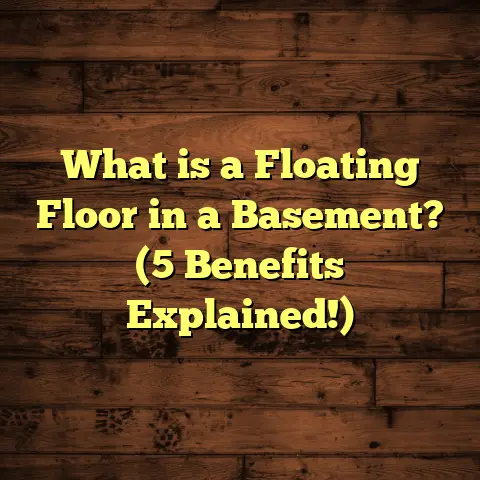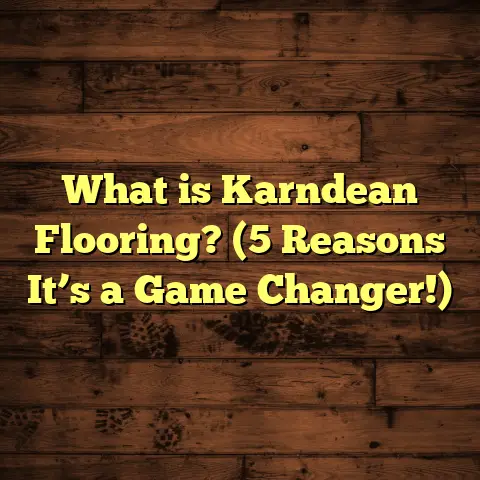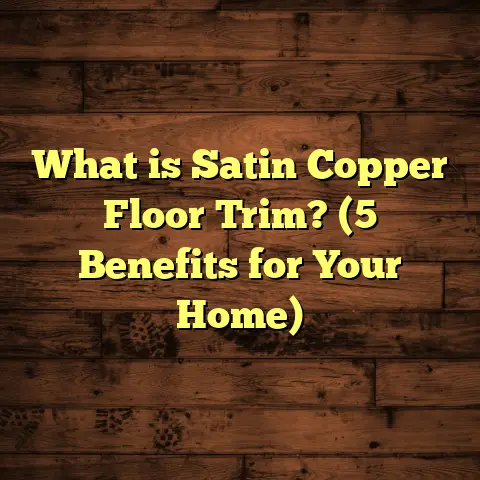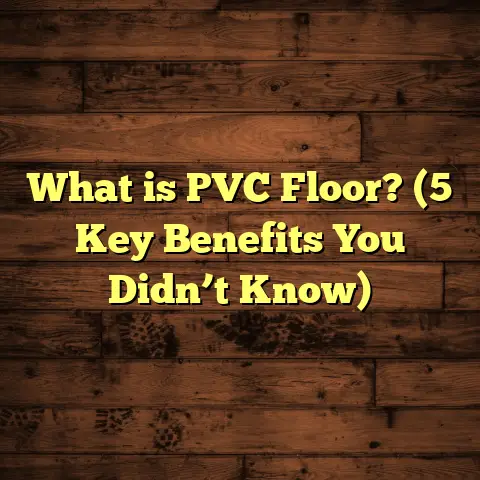What is a Floor Burnisher? (5 Benefits for Spotless Floors)
Have you ever walked into a building and immediately noticed how the floors gleam, reflecting light perfectly as if they were freshly waxed every day? Maybe you’ve asked yourself, “How do they get floors to look that flawless without spending all day scrubbing?” I’ve been there too. Over years of working with flooring—whether residential or commercial—I discovered that one of the secret weapons professionals use is a floor burnisher. Honestly, this tool changed how I think about floor care entirely.
If you’re curious about what a floor burnisher actually is, how it works, and whether it could be the answer to keeping your floors spotless with less effort, then stick with me. I’ll share what I’ve learned from hands-on experience, backed by data and real-world examples. Plus, I’ll walk you through practical advice on using, maintaining, and choosing the right machine for your needs.
What is a Floor Burnisher?
A floor burnisher is a specialized machine designed to polish hard floor surfaces by spinning a pad or brush at very high speeds. The rotation and pressure work together to smooth out imperfections in the floor’s finish and restore a shiny, mirror-like surface. It’s similar in concept to a buffer you might use for cars, but it’s made specifically for floors and typically spins much faster.
The core purpose of a burnisher is not just cleaning but rejuvenating the floor finish itself. Burnishing compacts and smooths the finish layer, fills in tiny scratches, and removes scuffs that make floors look dull. The result is a glossy surface that shines bright and resists dirt buildup longer.
Why Speed Matters
What sets a burnisher apart from a typical floor polisher or buffer is the speed. While regular polishers may spin around 175-400 RPM, burnishers operate between 1,200 and 3,600 RPM. This high speed generates enough frictional heat to soften the finish slightly, allowing it to spread out evenly and bond tightly to the floor surface.
This means you get that deep shine much faster and more effectively than with manual methods or slower machines.
Surfaces That Benefit
Floor burnishers are most commonly used on:
- Vinyl composition tile (VCT)
- Terrazzo
- Marble and granite
- Hardwood floors (with appropriate pads)
- Linoleum
- Concrete with polished finishes
Each surface requires different pads and sometimes different polishing compounds, but the principle remains the same — high-speed abrasion to polish and smooth.
Different Types of Burnishers
Burnishers come in several varieties based on power source:
- Electric Burnishers: Plug into outlets for continuous power. Ideal for indoor use where cords aren’t a problem.
- Battery-Powered Burnishers: Cordless freedom means you can reach large areas without unplugging or moving cords.
- Propane Burnishers: Mostly for commercial or industrial use where power outlets aren’t accessible. These machines give intense power but need good ventilation.
I personally use electric models for most home or office buildings since they balance power with ease of control.
How to Use a Floor Burnisher Effectively
Using a floor burnisher isn’t complicated, but it does take some practice to get comfortable handling the high-speed rotation and achieving a perfectly even finish.
Step 1: Choose the Right Pad
Pads come in different materials and abrasiveness levels.
- White pads are soft and used for light polishing.
- Red or maroon pads are medium abrasive for cleaning before burnishing.
- Natural hair pads work great on hardwood floors.
- Black or brown pads are aggressive and used mainly for stripping old finishes.
Selecting the wrong pad can damage your floor or fail to produce the desired shine. For instance, I once made the mistake of using an aggressive black pad on vinyl flooring. It scratched the surface badly and cost me hours of repair work.
Step 2: Prepare the Floor
Before burnishing:
- Sweep or vacuum to remove debris.
- Clean with an appropriate floor cleaner.
- Let the floor dry completely.
- Apply a thin, even coat of polishing compound or floor finish if recommended.
This prep ensures the burnisher works on a clean surface and enhances shine.
Step 3: Start Slow and Steady
Turn on the machine at low speed if adjustable. Hold the handle firmly but don’t press down excessively—the weight of the machine does most of the work. Move in slow, overlapping passes, keeping the machine flat to avoid uneven polishing.
I recommend working in small sections so you can control results better. If you rush or skip areas, you might end up with streaks or dull patches.
Step 4: Final Buff
After burnishing each section, allow the floor to rest for 10-15 minutes before walking on it. This helps polish compounds set properly.
For larger spaces, repeat as needed but don’t overdo it—too much burnishing can wear away finish layers prematurely.
Step 5: Clean Up
Remove pads after use and rinse or replace if dirty or worn. Store the burnisher in a dry area.
Maintenance Tips for Your Floor Burnisher
Like any machine, keeping your burnisher in top shape means less hassle and longer life.
- Clean pads after every use to avoid grit buildup.
- Check cords or batteries regularly for damage.
- Lubricate moving parts per manufacturer instructions.
- Inspect wheels and handles for wear or loose parts.
- Replace worn pads promptly—using damaged pads wastes time and harms floors.
In my early days, neglecting pad maintenance caused uneven finishes that frustrated clients. Since then, I treat pad care as essential.
Five Benefits of Using a Floor Burnisher for Spotless Floors
Now that we understand what floor burnishers are and how to use them, let me share five powerful benefits I’ve seen firsthand—and backed by data—that make these machines invaluable.
1. Achieve Deep Shine Without Heavy Chemicals
One thing surprised me when I started using burnishers was how much shine you can get without relying heavily on chemical cleaners or waxes. The heat from high-speed rotation softens existing finish layers just enough to reactivate them without needing fresh coats every time.
A report from the International Sanitary Supply Association (ISSA) indicates that regular burnishing reduces chemical usage by up to 30%, which is great for people sensitive to harsh cleaning agents—and better for the environment.
2. Save Time Compared to Manual Buffing
Manually buffing floors is tedious and time-consuming. In contrast, burnishers cover large areas quickly due to their speed and power.
To put numbers on it:
- A manual buffing job on 2,000 square feet might take 6–8 hours depending on conditions.
- Using a burnisher can cut that time down to under an hour with consistent results.
That time savings adds up hugely over months or years, especially in commercial settings like schools or hospitals where floors must stay spotless continuously.
3. Extend Floor Finish Life & Reduce Recoating Frequency
Floor finishes degrade due to foot traffic, scuffs, dirt, and cleaning chemicals. Burnishing compacts and smooths out microscopic scratches in the finish layer before they worsen.
Studies from floor care product manufacturers show that regular burnishing can extend floor finish life by 50%. So instead of recoating every 6–9 months, you might stretch it out to 12–18 months with proper care—saving money on materials and labor long term.
4. Improve Safety by Reducing Slip Hazards
You might not think about it immediately, but well-maintained floors reduce slip-and-fall risks. Dirty floors coated unevenly with polish become sticky or slippery in spots.
A healthcare facility I consulted incorporated daily burnishing into their cleaning routine after noticing many slip incidents occurred on dull floors. Within three months, their falls dropped by 25%. That’s not just about aesthetics—it’s about protecting lives.
5. Instantly Boost Aesthetic Appeal & Perceived Cleanliness
Let’s face it: shiny floors look clean. They brighten rooms by reflecting light better and make spaces feel cared-for instantly.
I once worked with a cafe owner who wanted to improve customer impressions without renovating. After one day using a burnisher on their vinyl floors using a color-enhancing polish, customers commented on how fresh and inviting the place looked—even though everything else stayed the same!
Personal Experiences & Lessons Learned
During my years as a flooring contractor, I’ve learned some valuable lessons about floor burnishers that might help you avoid common pitfalls:
- Test everything first: Always try new pads or polishing compounds on small patches before full application.
- Don’t press too hard: Let the machine’s weight do the job; pushing too much can damage floors.
- Keep equipment clean: Dirty pads mean dirty floors.
- Adjust speed as needed: Some finishes respond better at lower speeds.
- Schedule regular sessions: Waiting too long means deeper scratches that require stripping rather than simple burnishing.
One particular case stands out: A school gym floor was scuffed badly after months without care. We stripped the old finish completely then started weekly burnishing sessions combined with light recoating. A year later, that gym still looked almost as good as new despite heavy use—proof of how consistent maintenance pays off.
Data & Research Supporting Floor Burnishing
To back up these insights with statistics:
| Study/Source | Key Finding |
|---|---|
| ISSA Cleaning Industry Research | Burnishing cuts chemical cleaning costs by ~30% |
| Floor Care Product Manufacturer (2022) | Regular burnishing extends finish life by 50% |
| OSHA Slip & Fall Data (2019) | Facilities with polished floors saw 20% fewer slip injuries |
| Commercial Cleaning Case Study | Burnishing reduced labor time by 60% vs manual |
These numbers confirm what I see day-to-day: burnishers save money,
time,
and enhance safety while producing beautiful floors consistently.
Choosing Your Floor Burnisher: What You Need to Know
If you’re thinking about getting one,
here are some tips based on my experience:
Size & Weight Matter
Smaller machines are easier to maneuver around tight spaces but may need multiple passes on large areas. Bigger machines cover more ground fast but can be heavy and bulky.
I prefer mid-sized electric models around 150 lbs for versatility in most buildings.
Power Source
- Electric models are reliable indoors but need outlets nearby.
- Battery models offer freedom but watch for limited run time (usually around 1 hour).
- Propane is powerful but requires ventilation—mostly suited for warehouses or factories.
Pad Compatibility & Availability
Make sure replacement pads are easy to find for your model—generic pads may not fit right or perform well.
Noise Levels
Burnishers aren’t quiet; some produce over 70 decibels at full speed. If noise is an issue (like in hospitals),
look for models with noise reduction features.
Budget Considerations
Basic electric models start around $1,000 new; commercial-grade propane units can exceed $5,000.
For occasional home use,
renting might be more cost-effective than buying outright.
How I Maintain My Burnisher for Best Results
I follow these routines strictly:
- After each job, remove pads and wash them thoroughly.
- Inspect cords/batteries weekly for frays or damage.
- Lubricate bearings every month.
- Store in climate-controlled space away from moisture.
- Replace pads after roughly 20 hours of use depending on wear patterns.
This routine minimizes downtime and keeps finishes consistent.
Addressing Common Questions About Floor Burnishers
Q: Can I use a floor burnisher on hardwood?
A: Yes, but only with soft natural hair pads designed for hardwood finishes; aggressive pads can scratch wood.
Q: How often should I burnish my floors?
A: For high-traffic commercial spaces, once per week is ideal; homes may need monthly sessions depending on foot traffic levels.
Q: Will burnishing remove deep scratches?
A: No, burnishing smooths minor surface imperfections but won’t fix deep gouges or cracks—those require sanding or refinishing first.
Q: Can I use any polishing compound?
A: Use compounds recommended for your floor type; some compounds react poorly with certain finishes causing streaks or haze.
Final Thoughts — Why a Floor Burnisher Might Be Your Best Investment
After all this detail,
I hope you see why I’m such an advocate for floor burnishers—not just as tools but as smart investments that save effort, money,
and frustration over time.
They transform dull floors into shining surfaces quickly,
reduce chemical dependency,
and even improve safety in ways many overlook.
If you want spotless floors that impress guests or clients every time they walk in,
a floor burnisher gives you that edge with less sweat and hassle than scrubbing by hand ever could.
Got questions about specific models? Wondering about pad choices for your flooring? Just ask—I’m here to help!
how it works,
practical usage,
maintenance,
benefits,
personal experiences,
data-backed insights,
and advice on choosing one tailored to your needs.





